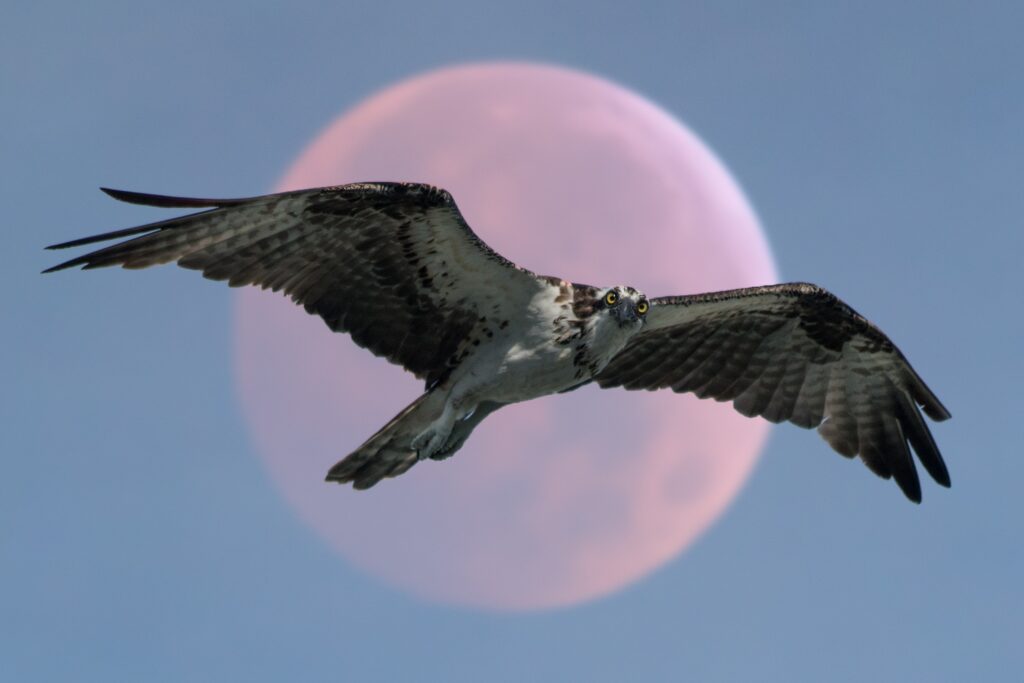The osprey, also known as the sea hawk, river hawk, and fish hawk (Pandion haliaetus), is a nocturnal, fish-eating bird of prey with a wide geographic range. It is a sizable raptor that can grow to be more than 60 cm (24 in) long and 180 cm (71 in) across the wings. The head and underparts are primarily greyish, while the upper parts are brown.
The Osprey- one of the must see raptors of Kabini, the bird can nest anywhere close to the water with a sufficient quantity of food since it can endure a wide range of habitats. Except for Antarctica, it can be found on every continent, albeit it only migrates through South America as a non-breeding individual.
As implied by its other common names, fish makes up most of the osprey’s diet. It has specialised physical features and displays unusual behaviour to help it hunt and catch prey. It has been assigned its own taxonomic genus, Pandion, and family, Pandionidae, due to these distinctive qualities.
Red Earth, our resort in Kabini is conveniently located at the edge of the Kabini backwaters, providing the perfect opportunity to sight both these magnificent birds of prey. And our naturalists are there to make sure you have every chance of a good sighting!

Distribution and Habitat
One of only six terrestrial birds with a global range, the osprey is the second most widespread raptor species after the peregrine falcon. With the exception of Antarctica, it can be found in temperate and tropical climates on all continents. It breeds in North America between Alaska and Newfoundland and Florida’s Gulf Coast, wintering further south from the southern United States all the way down to Argentina. Summertime distribution in Europe extends northward into Ireland, Scandinavia, Finland, and Great Britain, but not Iceland; wintertime distribution is in North Africa. Although it is a non-breeding visitor to eastern Victoria and Tasmania, it spends most of its time sedentary and scattered around the coastline in Australia.
The distance between its westernmost breeding site in South Australia and the closest breeding sites to the west in Western Australia is 1,000 km (600 mi), which corresponds to the coast of the Nullarbor Plain.
It can be found in the Pacific island nations of New Caledonia, the Bismarck Islands, and the Solomon Islands. Adult and juvenile fossil remains have also been discovered in Tonga, where it is thought that the arrival of humans caused the extinction of the species. It’s probable that it formerly covered Fiji and Vanuatu as well. In all of South Asia, as well as Southeast Asia, from Myanmar to Indochina and southern China, to Indonesia, Malaysia, and the Philippines, it is unusual to moderately frequent winter visitors.
The species’ unusually extensive geographic distribution is only known in five other land-based bird species.
Diet
The majority of the osprey’s diet, which consists solely of fish, is aquatic. Although practically every species of fish from 50 g (1.8 oz) to 2 kilogram (4.4 lb) can be taken, it frequently takes live fish weighing 150-300 g (5.3-10.6 ounce) and measuring approximately 25-35 cm (9.8-13.8 in). Esox lucius, an even larger northern pike, has been caught in Russia at 2.8 kg (6.2 lb).
Osprey at Kartung, Gambia, munching on a recently caught fish. Its tongue frequently protrudes out while it is ingesting food, as is characteristic.
The vision of ospreys is particularly suited to spotting aquatic items from the air. The osprey initially sees its prey while it is 10–40 m (33–131 ft) above the water. Then, it hovers briefly before diving feet first into the water. They dive into a body of water to catch fish, even submerging their entire bodies. An osprey changes its angle of flight as it dives to take into account the distortion of the fish’s image brought on by refraction. Ospreys usually typically eat on a nearby perch, although they have also been observed flying larger distances with their catch.
Migration
Female ospreys tend to migrate to Africa earlier than males, according to studies on Swedish ospreys. In the course of their autumn migration, more stops are made. Autumn timing and duration variations were more erratic than spring ones. They travel an average distance of 260–280 km (160–170 mi) per day, with a maximum distance of 431 kilometres (268 mi), even though they spend most of the day migrating. An osprey that was tagged in Norway and is being watched in western India suggests that European birds may also spend the winter in South Asia. Ospreys in the Mediterranean region exhibit partial migration, with some birds staying put while others fly very short distances.
Mortality
Over half of the overall yearly death for Swedish ospreys occurs during migration, which has a much greater mortality rate than stationary times. These fatalities can also be divided into geographic patterns: Africa is where spring mortality is most prevalent, and it is linked to travelling over the Sahara desert. Accidents involving human services, such as nesting close to power cables or running into aircraft, can also result in death.
There are over 300 species of documented birds in Tadoba. The vast forest patches mingling with small grasslands and watering holes make for diverse ecosystems, allowing birds of all habitats to thrive.



